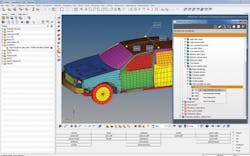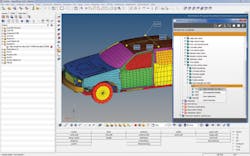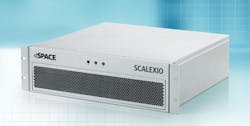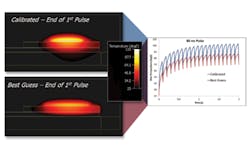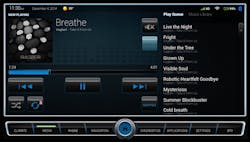Automotive tools span materials to infotainment
As the software content of cars increases, so does the complexity of the software tools used to design and debug vehicles. Simulation plays a key role, with software-only simulations giving way to hardware-in-the-loop (HIL) test as physical components become available. And real-time HIL simulations can require a processing boost. As for the embedded code itself, it needs to be debugged and deployed with multiple disciplinary issues in mind—engineers have to answer questions such as what are the mechanical design implications of assigning this particular piece of code to that particular processing resource?
In addition to performance issues, automakers want to deliver an impressive in-car user experience (UX) while also being able to deliver safety-critical information to the driver. Finally, cars are, of course, more than software, and engineers must make decisions about materials ranging from low-carbon steel to polymers and elastomers.
Indicating the importance of software for automotive design, simulation, and test are the plethora of products and upgrades announced in the last quarter of 2015 alone.
Simulation and model-based design
Addressing the materials issue is Granta Design, whose new GRANTA MI:Simulation software package delivers accurate materials data. Simulation is increasingly important in product development, enabling a deeper understanding of product performance, reducing reliance on expensive physical prototyping, and saving time in design, the company said. But simulation accuracy depends on the quality of the input data, particularly the models used to describe the physical properties of materials. GRANTA MI:Simulation ensures accurate, fully traceable derivation of these models, helps simulation analysts find and use the right materials data, and enables organizations to guarantee consistency and maximize returns from their investment in simulation.
The new package is based on the GRANTA MI materials-information-management system. The MI:Simulation package adds new tools to analyze this data and prepare the resulting models for computer-aided engineering (CAE). GRANTA MI:Data Analysis Apps will support key tasks, such as curve smoothing, averaging, and model fitting. These tasks usually need to be tailored to a user company’s specific properties and material types of interest and to their in-house or preferred analysis methods and models. Granta provides a sample app to extract tensile test data from a corporate database, process it, and make the resulting models available for simulation. Accompanying tools let you create your own apps or enable their creation by Granta’s Services Team.
The MI:Simulation package includes the user’s choice of MI:Materials Gateway software, which enables access from directly within CAE environments including Altair HyperMesh (Figure 1), ANSYS Workbench, Dassault Systèmes Abaqus/CAE, and Siemens NX.
Figure 1. MI:Materials Gateway for HyperMesh providing access to materials data
Courtesy of Granta Design
Sometimes simulations require a performance boost, and to that end dSPACE has introduced a new, more powerful processing unit (Figure 2) for its SCALEXIO HIL system to address the growing need for more real-time computation capability required for highly complex and high-fidelity simulation models. The increased computing power of the Intel Xeon E3 3.5-GHz processor will enable complex simulation scenarios for testing electronic control units in advanced driver assistance systems (ADAS) and vehicle-to-vehicle and vehicle-to-infrastructure communications; it also supports systems-of-systems engineering.
Courtesy of dSPACE
Maximizing return-on-simulation is the goal of Noesis Solutions with the 10.17 release of its Optimus software, featuring new interfaces for aerospace and other engineering-intensive industries as well as automotive companies. For example, with Optimus’ new interface for Computer Simulation Technology’s CST STUDIO SUITE, users can run parametric electromagnetic simulation campaigns, freeing them from repetitive manual model changes and data processing. With Optimus—offering design of experiments, response surface modeling, and numerical optimization methods—engineering teams can quickly identify product designs that meet a combination of objectives set by multiple (often competing) performance targets. At the same time, design constraints imposed by manufacturing realities or stringent regulatory and standardization requirements can be consistently taken into account.
For thermal simulation, Mentor Graphics has announced the newest version of its FloTHERM computational fluid-dynamics (CFD) software (Figure 3). FloTHERM was developed to quickly identify potential thermal issues early in the design process to avoid expensive late-stage redesign and warranty costs arising from thermal failures in the field. The newest version of FloTHERM delivers an automated method to calibrate simulation models to match transient thermal measurements recorded with the Mentor Graphics T3Ster hardware. As a result, FloTHERM can help maximize simulation data accuracy and provide additional insight into product reliability—a necessity for the automotive, aerospace, and electronics products industries.
Courtesy of Mentor Graphics
MathWorks didn’t introduce new products in the last quarter of 2015 (its 2016a release can be expected soon), but the company did announce in October that Toyota and DENSO, Toyota’s primary automotive electronics supplier, have chosen to transition their automotive mass-production programs from the MathWorks R2010b to the R2015a release. The 2015a release of the MATLAB and Simulink product families includes productivity enhancements in automatic code generation and verification.
Toyota and DENSO both use MathWorks modeling, simulation, and C code-generation products in their ECU production software development. With the spread of model-based design, both companies have been able to realize benefits such as productivity enhancement for the model-based design process, incremental development adoption (with support for incremental development from existing models), and continuous feature improvement, including Embedded Coder for automatic C code generation and Simulink Design Verifier for enhanced model verification capabilities.
MathWorks said that during the past five years it has enhanced product usability—such as by improving the Simulink and Stateflow editor to enable productivity boosts in model-based design. R2015a MATLAB and Simulink offer fast simulation restart capability, added incremental development support with the Model Slicer feature of Simulink Design Verifier, and enhanced simulation testing with Simulink Test.
According to Shigeru Kuroyanagi, head of Toyota’s motor control system infrastructure development group, in a prepared statement, “Toyota, DENSO, and MathWorks began cooperative development activities in 2003 to address the industry’s need in the vehicle-development field. Using R2010b as a third-generation toolset, we were able to apply automatic code-generation for mass production, and with R2015a we are able to further improve incremental development and design verification. Having the enhanced features for vehicle development, the result is a positive impact on our productivity.”
Infotainment
Today’s automakers and suppliers want to deliver an in-car UX that keeps drivers connected and informed, according to The Qt Company, and drivers want to extend their workplaces and homes into their connected cars. In furtherance of the software technology that is shaping the future of the automotive UX, Qt, creator of the Qt cross-platform development framework, teamed up with partners KDAB and Pelagicore to develop the Qt Automotive Suite, which supports the common in-vehicle-infotainment (IVI) system-development needs of automotive OEMs and tier 1 suppliers.
“Qt Automotive Suite delivers a modern multiprocess architecture enabling fluid 2D and photo-realistic 3D user experiences in combination with cloud services. The dual licensing scheme enables car makers to develop an ecosystem of innovation around their IVI offerings—from concept to production,” said Alwin Bakkenes, CEO of Pelagicore, in a press release.
“Platform-independent IVI and cluster software is a huge opportunity for the whole automotive industry,” added Kalle Dalheimer, CEO of KDAB. “KDAB’s and Pelagicore’s experience with the leading industry platforms, together with the tried and true foundation that is the Qt framework, deliver an opportunity to unify the development of automotive applications instead of doing them on a project-by-project basis.”
Qt also said the Qt framework, developed in conjunction with the open-source Qt Project, enabled the creation of a complete human-machine interface (HMI) for a smart in-vehicle infotainment (IVI) system (Figure 4) in nine weeks. Integrated Computer Solutions, a provider of visual UX design and agile-software product-development services, built the system for Intel to demonstrate the ease with which highly graphical and interactive interfaces can be incorporated into next-generation motor vehicles.
Courtesy of The Qt Company
Mentor Graphics is combining the display of infotainment and safety-critical vehicle information (warnings of brake, engine, or tire problems, for example) with its Mentor Automotive Safety Certifiable Digital Instrument Cluster software, which can run on multicore or single-core SoCs and features a fast boot time. The company said the new solution addresses a key problem for the automotive OEMs: how to migrate safety-critical driver information to full-featured, graphically rich digital instrument clusters and comply with safety standards including ISO 26262 without pushing up hardware or safety certification costs. The new solution maintains low-overhead isolation of safety-related functions. It is built on precertified components such as the Nucleus SafetyCert real-time operating system, resulting in minimization of the number of lines of new code to be safety-certified.
Mentor said it worked with Socionext Embedded Software Austria GmbH to integrate the latter company’s CGI Studio development platform for automotive HMI with the Safety Certifiable Digital Instrument Cluster Solution. “The capability of the Mentor Automotive platform is complemented by the high-end graphics and unique mixed safety-criticality features of CGI Studio, resulting in a seamless end-to-end solution for safety-certifiable HMI from tooling to display,” said Reinhard Fuericht, general manager of Socionext’s CGI Studio business unit, in a press release. “Embedded software safety is one of the top requirements for vehicle systems designers, and our ability to merge safety-critical information from vehicle systems without compromising rich cluster graphics or functionality has been very well received by our customers,” added Rainer Oder, general manager, Mentor Automotive.
Mentor Graphics also supports automotive infotainment applications with its recently announced Mentor Automotive Connected OS software platform. The Connected OS software provides scalable frameworks for IVI, driver information, and ADAS applications. The automotive-grade platform facilitates faster time-to-market by solving automotive-specific challenges at the operating-system level.
The Connected OS software features a modular, GENIVI-based Linux platform with an enhanced board support package. Mentor said millions of its Linux-based automotive systems already have been successfully adopted into production programs, and that number is expected to exceed 50 million by 2018.
Mentor also announced the pre-integration of Ethernet Audio/Video Bridging (eAVB) into the Connected OS solution. Most of the in-car data, especially related to safety applications, must be transmitted in real time with high quality of service. Connected OS enables these applications through the support for emerging connectivity protocol eAVB to address the stringent requirements of low-latency time-sensitive applications and reserved data channels. The eAVB stack in the Connected OS solution is developed to IEEE AVB standards and is AVnu Alliance-compliant. Supported IEEE implementations include IEEE 802.1AS, 802.1Qat, 802.1Qav, 1722.1, and 1733.
Embedded software
dSPACE is assisting embedded software earlier in the development process with its latest RTI AUTOSAR Blockset product, which enables the frontloading of software development and validation activities by allowing engineers to execute production AUTOSAR-compliant application software on the dSPACE MicroAutoBox II real-time development platform. It is used by automotive manufacturers and other industries to develop applications such as engine controls and driver assistance systems and can be used with existing ECUs in the bypass mode. MicroAutoBox II features a high-end PowerPC processor, a comprehensive I/O set, and communication interfaces for major automotive bus systems including CAN, CAN FD, LIN, K-Line, FlexRay, and Ethernet.
With RTI AUTOSAR Blockset, engineers can combine control algorithms designed in MATLAB and Simulink together with individual AUTOSAR application software components running on MicroAutoBox II during development phases. Engineers also can import the complete AUTOSAR application software packaged with the OS as a virtual ECU and execute it on MicroAutoBox II for software validation.
Symtavision, a provider of timing-analysis software for planning, optimizing, and verifying embedded real-time systems, has extended its collaboration with iSYSTEM, an independent provider of embedded software debugging, analysis, and test tools such as testIDEA. This teamwork has resulted in the announcement of improved integration between Symtavision’s SymTA/S and TraceAnalyzer timing design tools and iSYSTEM’s debug and trace tools. The improved integration will better ensure the safety and reliability of automotive real-time software while speeding development and reducing costs.
The collaboration delivers Symtavision tool support for Best Trace Format, the preferred file format for the iSYSTEM debug and trace tool, enabling trace data from single and multicore ECUs to be imported into TraceAnalyzer for visualization and analysis of timing traces and validation of ECU scheduling. Timing models generated from the traces can be processed further in SymTA/S to perform worst-case and statistical timing analyses as well as to virtually change the scheduling and optimize the overall software architecture. The optimized configuration can be passed back to the iSYSTEM debug and trace tool via an ECU configuration tool and uploaded to the target, completing a round-trip workflow.
In addition, Vector Software, a provider of solutions for robust embedded software quality, announced the release of the VectorCAST version 6.4 test-automation platform for C/C++ and Ada development. VectorCAST 6.4 has new features and enhancements in data aggregation, reporting, usability, and tool integration. Major new features include function call coverage (required for ISO 26262 certification), static-analysis integration improvements, and new language-specific features for Ada development, such as VectorCAST/Ada Stub By Function and VectorCAST/Ada Change-Based Testing. With the latter, engineers can quickly and easily assess the impact of a source-code change not only on their code, but also on the entire software application.
Data analysis and publication
Targeting data analysis and publication-quality graphing for automotive and other applications is OriginLab. In October, the company announced the release of Origin and OriginPro 2016. OriginPro offers the features of Origin plus extended analysis tools.
Notable among the new features and enhancements in Origin and OriginPro 2016 is “Apps in Origin,” which can add specific graphing and analysis functionality. Dr. C. P. Yang, founder and CEO of OriginLab, explained in a press release that Origin is a mature product that has accumulated over 20 years of user feedback. Consequently, “… it gets to a point where introduction of new features is often lost amid the ocean of existing features. Customers frequently tell us that they use just 5% of the software. Going forward, OriginLab can put standalone features into Apps so users can decide what features they need to add to their Origin installation. Apps can be updated independently so bug fixes for Apps can be timely, as there will no longer be the need to wait for another version of Origin. Apps also are more visible as they are managed on our File Exchange website. Apps also can be developed by the Origin user community,” Dr. Yang said.
Other features of the 2016 release include a new color chooser, smart plotting with cloneable templates (which enable multilayer graphs with complex mapping of data plots to worksheet columns), batch analysis (which enables the cloning of a current workbook during multifile import), professional report generation from batch analysis using Microsoft Word templates, a dockable object-manager window to manage layers and data plots in a graph, and an improved dialog to send graphs to Microsoft PowerPoint.
Additional new features in Origin and OriginPro 2016 are tab-based dialogs for common analysis tools, easier customization of annotation labels, the capability to skip weekends and holidays in financial plots, and R Console and Rserve support to connect with R software (the free software environment for statistical computing and graphics).
Cost and weight optimization
And finally, Mentor Graphics is addressing not only software development and simulation but also the implications of where software and other vehicle components should be located. Implementation decisions, such as choosing the best processing resource for a software component, are hard to optimize because cross-discipline impacts are difficult to assess, the company points out. For example, relocating a software component may affect not only the processor characteristics, but also data-bus communications and wiring implementations.
To help answer implementation questions, Mentor announced its new Capital Systems tools, which allow implementations to be optimized for key parameters such as cost and weight while engineers within the various disciplines do not need to understand one another’s detailed syntax. The Capital Systems tools support functional connectivity capture, platform-level integration of those functions, and instant measurement of consequential impacts.
Luciano Lavagno, professor of electronics at Politechnico di Torino, who has a research interest in hardware/software co-design, commented in a press release, “These tools are unique because they capture all high-level functionality aspects at a single abstraction level. This information is projected onto a representation of the host platform, which could be a car, an aircraft, or indeed a distributed system-of-systems. Real-time metrics immediately show engineers the effect of their decisions, allowing rapid optimization. No complex internal data mappings are needed, so the tools are ideal for fast adoption by staff responsible for system implementation decisions.”
For more information
